Letter of employment template for immigration
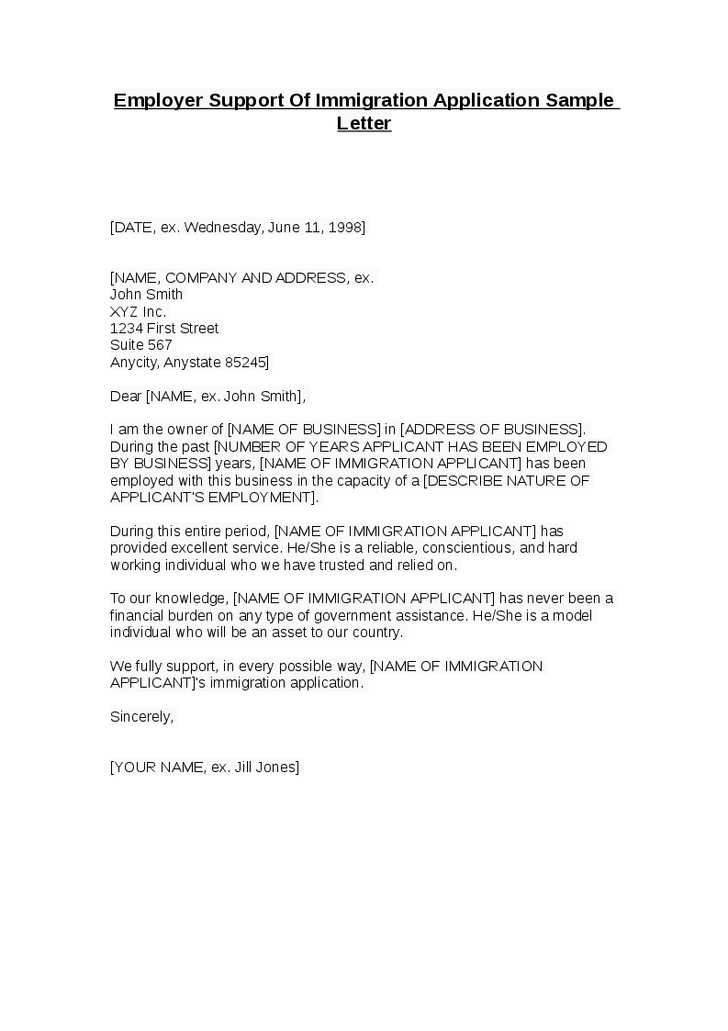
If you’re preparing an employment letter for immigration purposes, clarity and accuracy are key. The letter should serve as a formal confirmation of your employment status, including details that can verify your job and financial stability. Begin with a clear statement of the employee’s position, start date, and job responsibilities. It’s essential to make sure all relevant details are addressed in a concise and straightforward manner.
The letter should also include the company’s name, address, and contact information. Ensure the signatory is authorized to provide such a letter, and that they include their title and contact details. It’s helpful to include a brief description of the company’s business to give context to the position held. Confirm the employment type–whether full-time, part-time, or contract–and the expected salary or wage, as these details contribute to the evaluation of the applicant’s financial stability.
It is recommended that the letter be printed on the company’s official letterhead to ensure its authenticity. While the tone should remain professional, avoid unnecessary jargon or overly complex wording. Keeping the letter simple and direct ensures its relevance and usefulness during the immigration process.
- Employment Letter Template for Immigration
An employment letter for immigration purposes serves as formal verification of your job status, position, salary, and the nature of your work with your employer. Make sure the letter is concise and includes all necessary details for the immigration authorities to assess your situation. Below is a basic structure you can use to create the letter:
Key Elements to Include:
- Company Information: Start with the company name, address, and contact information. This ensures the letter’s authenticity and origin.
- Employee Information: Clearly state the employee’s full name, position, and job title. Mention the start date of employment and the type of employment (full-time, part-time, etc.).
- Job Responsibilities: Briefly outline the primary duties and responsibilities associated with the role. This helps clarify the employee’s role within the company.
- Salary and Benefits: Specify the employee’s salary or hourly wage, along with any benefits or bonuses they may receive.
- Employment Status: Confirm whether the employment is ongoing or if there’s a specific end date (for contract positions).
- Employer’s Contact Information: Include the employer’s name, job title, and contact details, ensuring the immigration office can reach out for any verification.
Sample Letter Format:
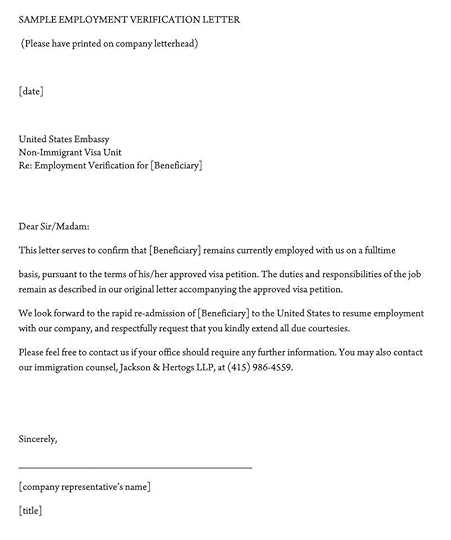
Dear Sir/Madam,
This letter is to confirm that [Employee’s Full Name] has been employed with [Company Name] since [Start Date] as a [Job Title].
[Employee’s Full Name] currently works [Full-time/Part-time] and is responsible for [Brief Job Responsibilities]. They receive a salary of [Salary Amount] annually/monthly, in addition to [Any Benefits or Bonuses].
If you require further details or clarification, feel free to contact me at [Employer’s Contact Information].
Sincerely,
[Employer’s Full Name]
[Job Title]
[Company Name]
[Company Contact Information]
To craft a clear and informative employment letter for immigration purposes, focus on these specific details:
1. Company Information
Start with the full name of the company, its address, and contact information. This confirms the legitimacy of the employer and provides proof of your working relationship. Include the company’s official registration details if applicable.
2. Employee’s Full Details
State the employee’s full name, job title, and a brief description of their duties. This section should make clear the employee’s role within the organization and demonstrate their contribution to the company.
3. Employment Dates
Clearly indicate the employee’s start date, and if relevant, their end date. This information helps establish the length of employment, which can be important for immigration assessment.
4. Employment Type and Status
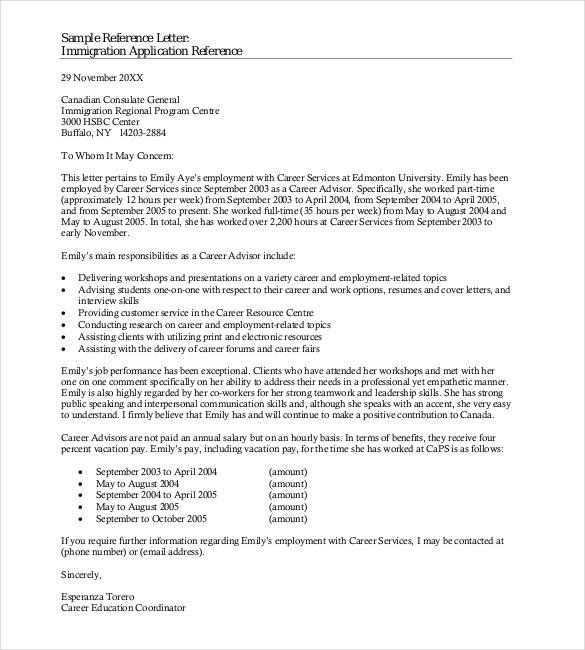
Specify whether the employee is full-time, part-time, temporary, or permanent. This distinction clarifies the nature of the employment and can impact visa eligibility.
5. Salary and Benefits
Provide details on the employee’s salary, including the amount, frequency of payment, and any additional benefits such as bonuses, health insurance, or retirement plans. This helps immigration authorities understand the employee’s financial stability.
6. Job Stability
If applicable, confirm the employee’s ongoing status with the company. This can assure authorities that the job is stable and that the employee is not at risk of losing their position soon.
7. Employer’s Signature and Contact Information
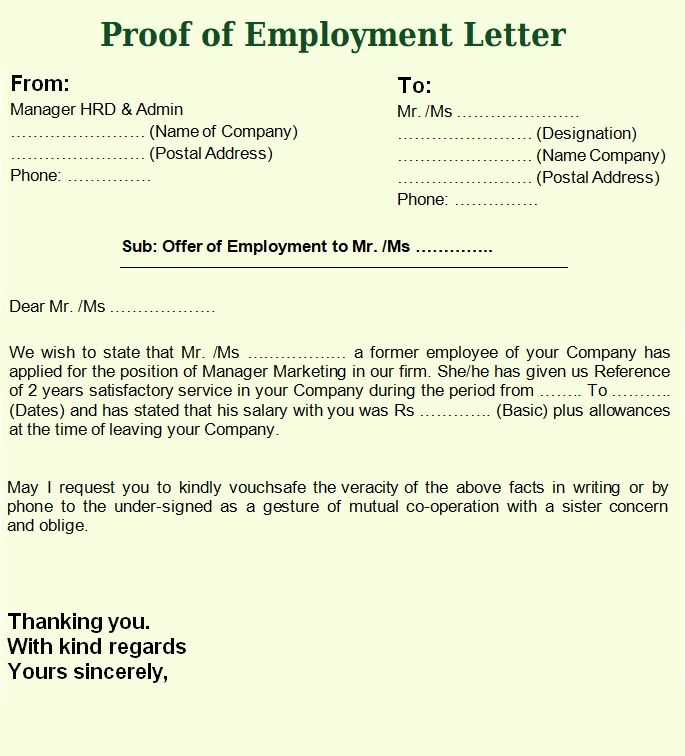
End the letter with the employer’s signature and contact details. This ensures that the immigration authorities can verify the information provided if necessary.
By covering these key elements, you provide a clear and reliable picture of the employee’s professional background, which supports the immigration process.
Keep the job letter clean, organized, and easy to read. Clear formatting will make a strong first impression. Here are the key points to follow:
1. Use a Standard Business Letter Format
- Align text to the left and use a single-spaced layout.
- Include the sender’s address at the top left, followed by the date, and then the recipient’s address.
- Always begin with a formal salutation (e.g., “Dear Mr. Smith”).
2. Font and Size
- Choose a professional font like Arial or Times New Roman.
- The font size should be 10-12 points for readability.
- Use bold or italics sparingly to highlight important details.
3. Keep Paragraphs Short
- Avoid long, dense paragraphs. Break text into smaller, digestible chunks.
- Each paragraph should have a clear purpose, such as introducing the candidate, detailing the role, or explaining job duties.
4. Use Bullet Points for Clarity
- List job responsibilities and achievements in bullet points to improve readability.
- This allows the reader to quickly understand the candidate’s qualifications.
5. Clear and Concise Language
- Avoid jargon or overly complex phrases. Keep the language professional but simple.
- Stay focused on the key aspects of the job role and qualifications.
6. Professional Tone
- The tone should be respectful, polite, and formal. Keep personal emotions or casual language out.
- Maintain a positive and neutral stance throughout the letter.
Directly addressing the immigration authorities is key to ensuring your letter appears professional and is processed correctly. Start by using the appropriate title for the recipient. If you know the specific official’s name, use “Dear [Full Name],” for example, “Dear John Smith.” In case the name is unknown, use a general but formal approach like “Dear Sir or Madam” or “To Whom It May Concern.” Avoid informal greetings such as “Hey” or “Hello.” These convey an unprofessional tone, which may impact the perception of your letter.
Use Proper Titles and Salutations
Always use official titles when possible. For example, “Dear Officer [Last Name]” or “Dear Immigration Officer.” If you are addressing a specific department or office, ensure you use the correct title for that department, such as “Dear Visa Officer” or “Dear Consular Officer.” Properly addressing the official will show respect and demonstrate your understanding of formal communication protocols.
Clarify Your Purpose Early
Start the body of the letter by briefly stating the purpose of your communication. Be direct but polite. This helps the official quickly understand the nature of your request and facilitates a smoother review process. For example, “I am writing to request clarification on the requirements for my visa application” or “I am submitting the necessary documents to support my work permit application.” This approach saves time and ensures the letter is addressed efficiently.
| Correct Approach | Incorrect Approach |
|---|---|
| Dear Immigration Officer, | Hey Immigration Team, |
| Dear Consular Officer, | Hello, |
| Dear Visa Officer, | To Whom it May Concern, |
Ensure that your letter uses clear and respectful language, focusing on the specifics of your request without unnecessary details. Keep the communication formal and concise, which allows the official to review your case more efficiently.
Common Errors to Avoid When Writing the Employment Letter
One of the most frequent mistakes when writing an employment letter is not including the correct job title. This might seem like a small issue, but it can lead to delays or rejection of your immigration application. Always ensure that the title matches exactly what appears in official documents like your contract or paycheck.
1. Missing or Incorrect Contact Information
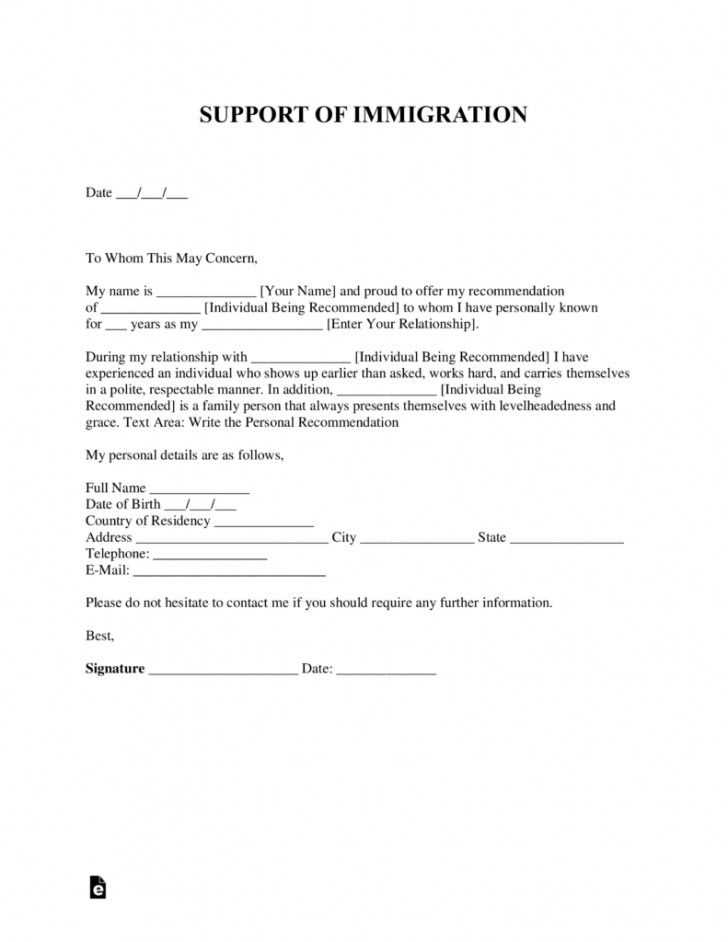
Make sure to include accurate contact details for both the employer and the employee. This should include a physical business address, phone number, and email address. Double-check that the contact information is valid, as it may be used to verify employment details.
2. Failing to Specify Employment Dates
Clearly outline the start and, if applicable, the end date of employment. Not stating the duration of the employment or using vague language like “current” or “ongoing” may confuse immigration authorities and lead to unnecessary delays.
3. Lack of Salary or Wage Information
Omitting salary or wage details is another common mistake. Include both annual and hourly wages, as this helps to establish the financial stability of the applicant. Always verify the amounts against official payroll records to avoid discrepancies.
4. General or Vague Descriptions of Job Duties
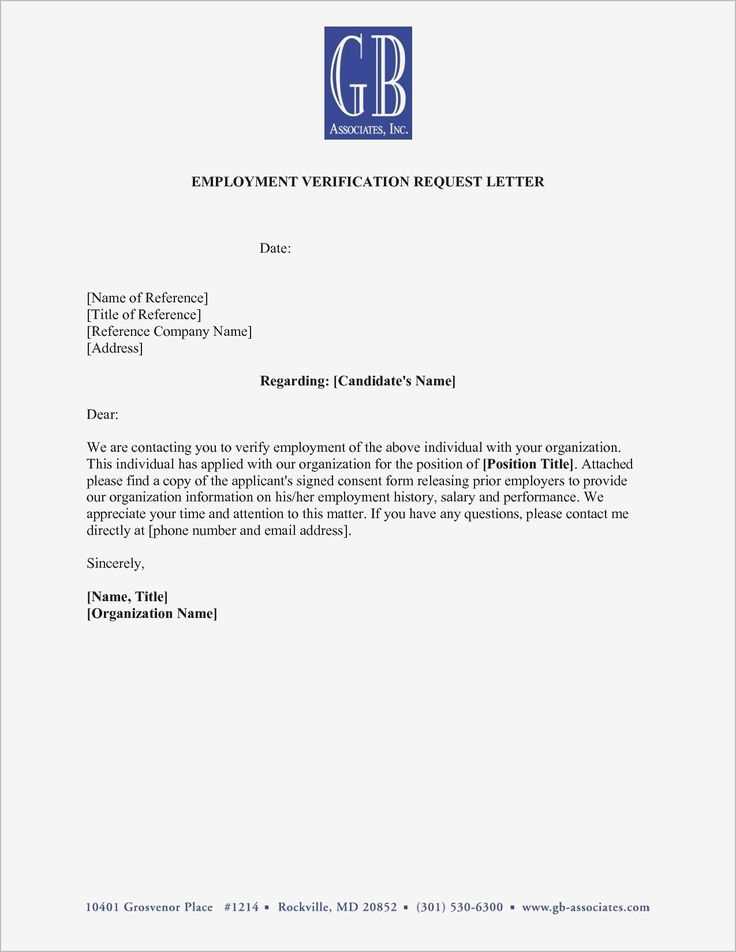
Be specific about job duties and responsibilities. A generic description like “performs various tasks” won’t provide enough information. Instead, list the key responsibilities with enough detail to demonstrate the employee’s qualifications for their role.
5. Unprofessional Tone or Formatting
The letter should be clear, formal, and well-organized. Avoid using informal language, excessive abbreviations, or unclear formatting. Ensure the letter is typed on company letterhead and signed by an authorized person, such as a manager or HR representative.
6. Omitting the Employer’s Legal Standing
It’s important to state that the employer is a legitimate entity. This includes providing the employer’s business registration number or tax ID number. This helps to authenticate the company and strengthen the credibility of the employment claim.
7. Using Outdated Job Descriptions
Ensure that the job description reflects the employee’s current role and responsibilities. Using outdated descriptions could give the impression of misleading information, potentially jeopardizing the immigration process.
To ensure your employment letter meets immigration requirements, include the following documentation:
| Document | Description |
|---|---|
| Proof of Identity | Submit a government-issued ID, such as a passport or driver’s license, to verify your identity. |
| Job Description | Provide a detailed description of your role and responsibilities within the company. This helps confirm the relevance of your job to the immigration application. |
| Employment Contract | A copy of your signed employment contract should be included to prove your employment status and the terms of your job. |
| Pay Stubs | Submit recent pay stubs (typically the last three) to verify your salary and employment duration. |
| Company Letterhead | The employment letter should be printed on company letterhead, with the official contact details of the employer. |
| Tax Information | If applicable, include tax documents such as a W-2 (in the U.S.) or payslips that show your tax status and contributions. |
| Immigration Forms | Complete and submit any required immigration forms or application documents specific to your case. |
Ensure all documents are clear, current, and complete. Providing these pieces will support your application and prevent delays in the immigration process. Double-check the immigration authority’s specific requirements, as they may vary depending on the visa type or country.
For each visa type, tailor the employment letter to highlight the details that best align with the visa’s specific requirements. For a work visa, mention the job title, specific skills required, and the length of the employment. Focus on the applicant’s role in fulfilling critical tasks within the company. Include information on the company’s legitimacy, such as registration details, and emphasize the applicant’s qualifications and work experience relevant to the job position.
For a family-based visa, the employment letter should highlight the applicant’s job stability and ability to financially support family members. Specify the current salary, including bonuses or other benefits, and clarify the consistency of income. It’s important to demonstrate that the applicant has the means to support dependents during their stay.
For student visas, focus on the applicant’s full-time status and the nature of the employment as it relates to their studies. Mention how the role complements the educational background or supports the applicant’s long-term academic goals. Provide details on work hours, and ensure the employer confirms flexibility around the student’s class schedule.
In the case of a permanent residency application, emphasize the applicant’s long-term contributions to the company, their professional growth, and any specialized skills that make them indispensable. Stress the permanence of the position and the applicant’s role in the company’s success, showing that they fulfill an ongoing need in the workforce.
In each case, be clear, concise, and specific. Avoid generic statements and ensure the letter directly addresses the requirements laid out by the immigration authorities for the particular visa category.
Letter of Employment Template for Immigration
A letter of employment is a key document in many immigration processes. This letter verifies the applicant’s current employment status and details the role within the company. Ensure the document includes the following elements:
Key Elements to Include
- Employer’s Details: Name, position, and contact information of the employer should be clearly listed at the top.
- Employee’s Information: Full name, job title, and start date at the company.
- Job Description: A brief overview of the employee’s duties and responsibilities.
- Salary Information: Mention the salary, payment frequency, and any additional compensation or benefits.
- Duration of Employment: Indicate whether the position is permanent, temporary, or contractual, with the duration of the contract if applicable.
- Work Schedule: List typical working hours and days, especially if the applicant is employed on a part-time basis.
- Employer’s Signature and Date: Ensure the letter is signed and dated by a company representative, usually someone from HR or a manager.
Best Practices
- Be Clear and Specific: Avoid vague terms. Immigration authorities appreciate detailed and accurate information.
- Use Official Letterhead: The letter should be printed on the company’s official letterhead for authenticity.
- Check for Accuracy: Ensure all information matches the applicant’s records, including dates, salary, and job title.
A well-constructed employment letter ensures smoother processing of immigration applications. Adjust the content based on the specific requirements of the immigration authorities involved.